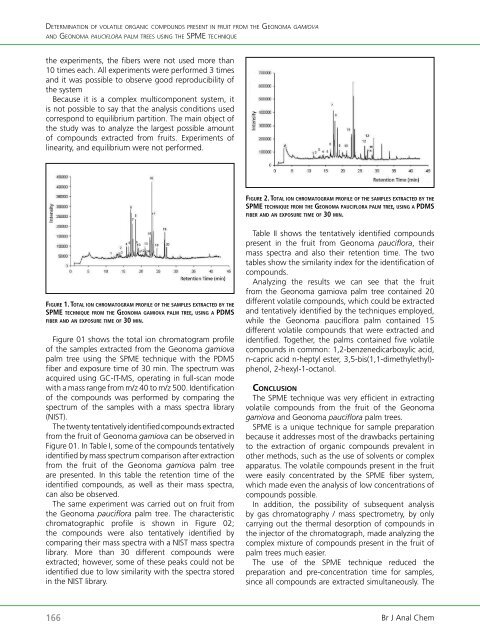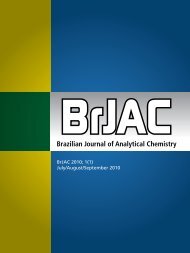Brazilian Journal of Analytical Chemistry - BRJAC - Brazilian Journal ...
Brazilian Journal of Analytical Chemistry - BRJAC - Brazilian Journal ...
Brazilian Journal of Analytical Chemistry - BRJAC - Brazilian Journal ...
Create successful ePaper yourself
Turn your PDF publications into a flip-book with our unique Google optimized e-Paper software.
determination o f volatile o r g a n iC C o m p o u n d s present in f r u i t f r o m t h e ge o n o m a g a m i o v a<br />
a n d ge o n o m a p a u c i f l o r a p a l m trees u s i n g t h e spme t e C h n i q u e<br />
the experiments, the fibers were not used more than<br />
10 times each. All experiments were performed 3 times<br />
and it was possible to observe good reproducibility <strong>of</strong><br />
the system<br />
Because it is a complex multicomponent system, it<br />
is not possible to say that the analysis conditions used<br />
correspond to equilibrium partition. The main object <strong>of</strong><br />
the study was to analyze the largest possible amount<br />
<strong>of</strong> compounds extracted from fruits. Experiments <strong>of</strong><br />
linearity, and equilibrium were not performed.<br />
fi g u rE 1. to t a l i o n C h r o m a t o g r a m P r o f i l E o f t h E samPlEs ExtraCtEd By t h E<br />
sPmE t E C h n i q u E f r o m t h E gE o n o m a g a m i o v a P a l m t rE E, u s i n g a Pdms<br />
fiBEr a n d a n ExPosurE t i mE o f 30 m i n.<br />
Figure 01 shows the total ion chromatogram pr<strong>of</strong>ile<br />
<strong>of</strong> the samples extracted from the Geonoma gamiova<br />
palm tree using the SPME technique with the PDMS<br />
fiber and exposure time <strong>of</strong> 30 min. The spectrum was<br />
acquired using GC-IT-MS, operating in full-scan mode<br />
with a mass range from m/z 40 to m/z 500. Identification<br />
<strong>of</strong> the compounds was performed by comparing the<br />
spectrum <strong>of</strong> the samples with a mass spectra library<br />
(NIST).<br />
The twenty tentatively identified compounds extracted<br />
from the fruit <strong>of</strong> Geonoma gamiova can be observed in<br />
Figure 01. In Table I, some <strong>of</strong> the compounds tentatively<br />
identified by mass spectrum comparison after extraction<br />
from the fruit <strong>of</strong> the Geonoma gamiova palm tree<br />
are presented. In this table the retention time <strong>of</strong> the<br />
identified compounds, as well as their mass spectra,<br />
can also be observed.<br />
The same experiment was carried out on fruit from<br />
the Geonoma pauciflora palm tree. The characteristic<br />
chromatographic pr<strong>of</strong>ile is shown in Figure 02;<br />
the compounds were also tentatively identified by<br />
comparing their mass spectra with a NIST mass spectra<br />
library. More than 30 different compounds were<br />
extracted; however, some <strong>of</strong> these peaks could not be<br />
identified due to low similarity with the spectra stored<br />
in the NIST library.<br />
fi g u r E 2. to t a l i o n C h r o m a t o g r a m P r o f i l E o f t h E samPlEs ExtraCtEd By t h E<br />
sPmE t E C h n i q u E f r o m t h E gE o n o m a P a u C i f l o ra P a l m t rE E, u s i n g a Pdms<br />
fiBEr a n d a n ExPosurE t i mE o f 30 m i n.<br />
Table II shows the tentatively identified compounds<br />
present in the fruit from Geonoma pauciflora, their<br />
mass spectra and also their retention time. The two<br />
tables show the similarity index for the identification <strong>of</strong><br />
compounds.<br />
Analyzing the results we can see that the fruit<br />
from the Geonoma gamiova palm tree contained 20<br />
different volatile compounds, which could be extracted<br />
and tentatively identified by the techniques employed,<br />
while the Geonoma pauciflora palm contained 15<br />
different volatile compounds that were extracted and<br />
identified. Together, the palms contained five volatile<br />
compounds in common: 1,2-benzenedicarboxylic acid,<br />
n-capric acid n-heptyl ester, 3,5-bis(1,1-dimethylethyl)phenol,<br />
2-hexyl-1-octanol.<br />
co n c l u s Io n<br />
The SPME technique was very efficient in extracting<br />
volatile compounds from the fruit <strong>of</strong> the Geonoma<br />
gamiova and Geonoma pauciflora palm trees.<br />
SPME is a unique technique for sample preparation<br />
because it addresses most <strong>of</strong> the drawbacks pertaining<br />
to the extraction <strong>of</strong> organic compounds prevalent in<br />
other methods, such as the use <strong>of</strong> solvents or complex<br />
apparatus. The volatile compounds present in the fruit<br />
were easily concentrated by the SPME fiber system,<br />
which made even the analysis <strong>of</strong> low concentrations <strong>of</strong><br />
compounds possible.<br />
In addition, the possibility <strong>of</strong> subsequent analysis<br />
by gas chromatography / mass spectrometry, by only<br />
carrying out the thermal desorption <strong>of</strong> compounds in<br />
the injector <strong>of</strong> the chromatograph, made analyzing the<br />
complex mixture <strong>of</strong> compounds present in the fruit <strong>of</strong><br />
palm trees much easier.<br />
The use <strong>of</strong> the SPME technique reduced the<br />
preparation and pre-concentration time for samples,<br />
since all compounds are extracted simultaneously. The<br />
166 Br J Anal Chem



